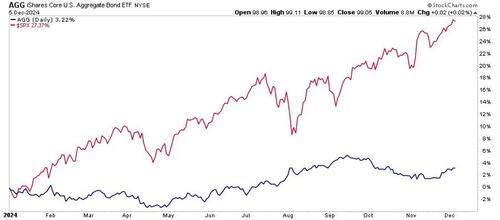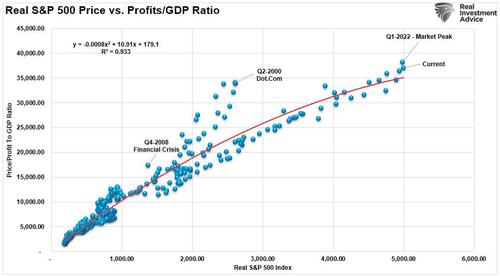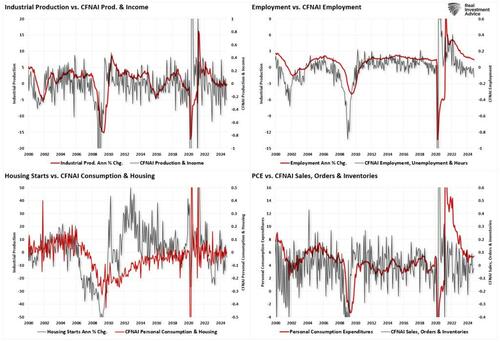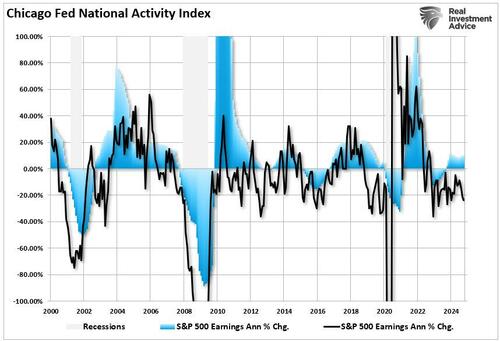Authored by Lance Roberts via RealInvestmentAdvice.com,
Everybody Is Very Bullish
Last week, we discussed how speculation and leverage have returned in earnest to the market as investors rush to take on increasing levels of risk. With markets rising steadily all year, it is unsurprising to witness investors lulled into an elevated sense of complacency. Stocks, bitcoin, leveraged investments, and meme stocks are all surging higher, which is certainly reminiscent of the “madness” we witnessed following the Covid lockdowns. I posted the following chart on “X” Friday morning for reference.
Of course, speculation and sentiment drive markets higher, and investors currently have little concern about a correction. Markets are overbought and detached from short-term moving averages. Furthermore, one of the near-term risks to more bullish investors is the combination of high stock valuations and the necessity of portfolio rebalancing, which could impact market stability. Using 2023 data, it is estimated that mutual funds in the United States hold approximately $19.6 trillion in assets, while exchange-traded funds (ETFs) manage about $8.1 trillion, suggesting a substantial number of portfolios containing combinations of stocks and bonds.
Portfolio Rebalancing Risk
With the year-end approaching, portfolio managers need to rebalance their holdings due to tax considerations, distributions, and annual reporting. For example, as of this writing, the S&P 500 is currently up about 28% year-to-date, while investment-grade bonds (as measured by iShares US Aggregate Bond ETF (AGG) are up 3.2%. That differential in performance would cause a 60/40 stock/bond allocation to shift to a 65/35 allocation. To rebalance that portfolio back to 60/40, portfolio managers must reduce equity exposure by 5% and increase bond exposure by 5%.
Depending on the magnitude of the rebalancing process, it could exert downward pressure on risk assets, leading to a short-term market correction or consolidation. Some of that rebalancing has already been in process, but we suspect there is more to go, particularly given the rather extreme reading of the stock-to-bond ratio.
Historically, the stock/bond ratio remained range bound between roughly 1:1 to 2.5:1. Today, that ratio has skyrocketed since the flood of liquidity following the pandemic as money chased risk assets over safety. At a ratio of 6.5:1, we suspect that, at some point, a reversion will take place. In the short term, given the outsized performance of stocks versus bonds in 2024, there is likely an unappreciated risk that portfolio rebalancing by managers could add a layer of selling pressure over the next couple of weeks.
However, repeating what we wrote last week, we expect any correction to be short-lived.
“If you are underweight equities, consider minor pullbacks and consolidations to add exposure as needed to bring portfolios to target weights. Pullbacks will likely be shallow, but being ready to deploy capital will be beneficial. Once we pass the inauguration, we can assess what policies will likely be enacted and adjust portfolios accordingly.”
While there is no reason to be bearish, this does not mean you should abandon risk management. Such is particularly the case as we head into 2025, which could suggest a less optimistic outcome.
2025 Earnings Forecasts Are Very Bullish
Last week, we discussed the surge in speculation and leverage in the market. As discussed in that article, even though valuations are elevated, such is because sentiment drives valuations in the short term. As we head into 2025, Wall Street is very optimistic about earnings growth, leading investors to pay up for higher valuations. Such is also the case with consumers whose confidence in higher stock prices over the next 12 months has surged to record levels.
According to S&P Global, earnings are expected to grow by 19.87% in 2025 from $209.83 to $251.53 per share. As discussed, such is well above the long-term earnings growth trend from 1900 to the present. Still, such exuberance is unsurprising during strongly trending bull markets in an attempt to justify higher valuations. The problem is that such exuberant forecasts rarely come to fruition. For example, in March 2023, S&P Global predicted that 2024 earnings would grow by 13% for the year. In reality, earnings grew by just 9% despite the market rising nearly 28%.
As shown, current estimates are well elevated above the running linear trend line from 2014, while actual earnings growth remains close to it. This suggests that we will likely see a decline in estimates for 2025 to roughly $225/share, equating to earnings growth of roughly 7%. Of course, the linear trend of earnings growth is a function of economic growth and an important consideration for investors betting on elevated returns in the New Year.
Earnings Can’t Outgrow The Economy
Crucially, earnings cannot outgrow the economy over the long term as earnings are derived from economic activity. Given that GDP measures the total value of goods and services produced within a country, it is a reliable gauge of overall activity. A growing GDP indicates increased economic activity, typically driving higher corporate earnings due to increased consumer spending and business investment. Conversely, a contracting GDP suggests an economic slowdown, often dampening corporate profits.
The data supports this concept. Historically, GDP growth has closely correlated with corporate earnings growth. Data from the Federal Reserve shows that, since 1948, a 1% increase in real GDP growth has translated to roughly a 6% increase in S&P 500 earnings on average. This relationship underscores why GDP is a cornerstone for assessing earnings trends. We can also see this visually.
“Since 1947, earnings per share have grown at 7.7% annually, while the economy expanded by 6.40% annually. That close relationship in growth rates should be logical, particularly given the significant role that consumer spending has in the GDP equation.” – Market Forecasts Are Very Bullish
A better way to visualize this data is to look at the correlation between the annual change in earnings growth and inflation-adjusted GDP. There are periods when earnings deviate from underlying economic activity. However, those periods are due to pre- or post-recession earnings fluctuations. Currently, economic and earnings growth are very close to the long-term correlation.
However, as we discussed previously, there is also a high correlation between the market and the corporate profits to GDP ratio. As is the case currently, markets can detach from underlying economic realities due to momentum and psychology for brief periods. However, those deviations are unsustainable in the long term, and corporate profitability, as discussed, is derived from underlying economic activity.
I will write an article soon covering the importance of a handful of economic indicators on earnings. However, I want to discuss two today: the ISM Manufacturing Index and the Chicago Fed National Activity Index.
ISM Manufacturing Index
The ISM Manufacturing Index is a widely followed leading indicator of economic activity in the manufacturing sector. It surveys purchasing managers on critical metrics like new orders, production levels, and employment.
As of late 2024, the ISM Manufacturing Index has been consistently below 50, marking a manufacturing recession. This data aligns with declining new orders and softer demand, raising concerns about corporate earnings resilience in 2025. However, while manufacturing only accounts for about 20% of U.S. GDP, it has an outsized influence that extends across supply chains, amplifying the impact on broader economic activity.
Corporate earnings growth, which correlates with economic indicators like the ISM Manufacturing index, suggests some caution about the more optimistic 2025 Wall Street estimates. However, even if we include the services side of the index, which comprises the bulk of economic growth, and weigh it accordingly, we see that the stock market has far outpaced underlying economic activity. Historically, such outsized returns have not been sustainable as earnings growth fails to meet expectations.
However, one of the better economic indicators to pay attention to is the Chicago Fed National Activity Index, which is a broad measure of the economy but does not receive much attention.
Chicago Fed National Activity Index (CFNAI)
The CFNAI aggregates 85 monthly economic indicators from four categories:
A CFNAI reading above zero indicates above-trend economic growth, while below zero suggests below-trend growth. In October 2024, the CFNAI registered at -0.15, reflecting subdued economic activity. Prolonged readings in negative territory often signal a rising risk of recession. Notably, the employment measure suggests that the annual rate of change in employment will continue to decline, industrial production will slow, and personal consumption will moderate lower.
The CFNAI’s broad scope provides a nuanced view of how various economic forces combine to affect corporate earnings. With production and employment metrics deteriorating, the outlook for robust earnings in 2025 appears increasingly strained. As shown, a high but volatile historical correlation exists between the CFNAI and corporate earnings.
Risks In 2025
Still, investors should note that analysts’ outlook for 2025 is exceptionally optimistic compared to what is likely to be the actual outcome. This is because, as discussed in “Market Forecasts Are Very Bullish,” there are numerous headwinds facing markets next year.
“The problem with current forward estimates is that several factors must exist to sustain historically high earnings growth and record corporate profitability.”
Economic growth must remain more robust than the average 20-year growth rate.
Wage and labor growth must reverse (weaken) to sustain historically elevated profit margins.
Both interest rates and inflation need to decline to support consumer spending.
Trump’s planned tariffs will increase costs on some products and may not be fully offset by replacement and substitution.
Reductions in Government spending, debt issuance, and the deficit subtract from corporate profitability (Kalecki Profit Equation).
Slower economic growth in China, Europe, and Japan reduces demand for U.S. exports, slowing economic growth.
The Federal Reserve maintaining higher interest rates and continuing to reduce its balance sheet will reduce market liquidity.
You get the idea. While analysts are currently very optimistic about economic and earnings growth going into 2025, there are risks to those forecasts. Such is particularly true when examining current economic data’s relative strength and trend. Subdued manufacturing activity, slowing GDP growth, and cautious consumer behavior all point to an economic environment less supportive of aggressive earnings growth. As such, investors must carefully navigate the disconnect between high Wall Street expectations and softening economic conditions.
If these headwinds persist, corporate earnings may grow slower or contract slightly compared to Wall Street’s current projections. For investors, this scenario could mean lower returns from equities, particularly in high-growth sectors more sensitive to earnings disappointments.
How We Are Trading It
Heading into year-end, there is little need to be overly cautious. The bullish trend remains intact, corporate buybacks continue, and investment managers must be “fully dressed” by New Year’s Eve for annual reporting.
However, even with the market in a seasonally strong period of the year, there is always the possibility of something “going wrong.” As such, continue to follow the rules as needed to maintain a manageable level of volatility.
Tighten up stop-loss levels to current support levels for each position. Hedge portfolios against major market declines. Take profits in positions that have been big winners Sell laggards and losers Raise cash and rebalance portfolios to target weightings. Notice, nothing in there says “sell everything and go to cash.”
The trick to navigating markets in 2025 is not trying to “time” the market to sell exactly at the top. That is impossible. Successful long-term management is understanding when “enough is enough” and being willing to take profits and protect your gains. For many stocks currently, that is the situation we are in.
Source link













